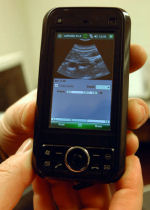The Ultrasound Smartphone
Computer engineers at Washington University in St. Louis have invented the ultrasound smartphone. They have coupled a USB-based probe with a smartphone, enabling a compact, mobile computational platform and a medical imaging device that fits in the palm of a hand.
William D. Richard, Ph.D., Washington University Associate Professor of Computer Science and Engineering, and David Zar, Washington University Research Associate in Computer Science and Engineering, have made commercial USB ultrasound probes compatible with Microsoft Windows Mobile phones. They received a $100,000 grant from Microsoft to make commercial USB ultrasound probes work with smartphones. To make it work, they had to optimize every aspect of probe design and operation, from power consumption and data transfer rate to image formation algorithms. The new ultrasound imaging technology will be used to probe the kidney, liver, bladder, and eyes, endocavity probes for prostate and uterine screenings and biopsies, and vascular probes for imaging veins and arteries for starting IVs and central lines.

"You can carry around a probe and cell phone and image on the fly now," said Richard of the ultrasound smartphone. "Imagine having these smartphones in ambulances and emergency rooms." "On a larger scale, this kind of cell phone is a complete computer that runs Windows. It could become the essential computer of the Developing World, where trained medical personnel are scarce, but most of the population, as much as 90 percent, have access to a cell phone tower." "Twenty-first century medicine is defined by medical imaging," said Zar. "Yet 70 percent of the world's population has no access to medical imaging. It's hard to take an MRI or CT scanner to a rural community without power."
This could bring twenty first century medical imaging to third world nations. The data can be gathered in remote places and brought to a doctor or clinic miles away for analysis and a diagnosis. Richard came up with the low-power probe electronics design. He began working on ultrasound system designs 25 years ago, and in that span he has shrunk the electronics from cabinet-sized to a tiny circuit board one inch by three inches. The cost has also shrunk. The ultrasound smartphone has a goal price tag of about $500. Most USB-based probes are about $2000. A unit in a clinic can range from $25,000 to more than $50,000, depending on how many bells and whistles you buy.
The smartphone is going into field trials in third world countries and is going to be useful in remote military operations soon. Richard and Zar demonstrated a fully functional compatible USB ultrasound smartphone probe at Microsoft Research Techfest 2009 in February, and Zar presented the technology at the 2009 World Health Care Congress held in Washington, D.C., from April 14th to the 16th.
If the ultrasound smartphone is interesting, the you should check out Hologram ultrasound.
Thanks to Washington University in St. Louis
Back to Genesis pregnancy ultrasound machine Home Page





